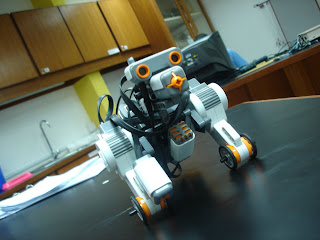Robotics has come to an end after a semester of hard work and programming. I have learned many new things such as robot construction, programming the NXT, and using each type of sensor.
On the subject of robot construction, the way I would go about building a robot now is very different than if I were to build a robot 6 months ago. I have learned many construction techniques that make a strong, stable, reliable, and interchangeable robot. To do this, you can't just slap a bunch of parts together. You must plan out everything and think about how each aspect will affect the stability of the robot. Another concept I learned was modularity. Modularity is the ability to take off one piece of the robot without having to take the whole robot apart. This came in handy for many of the challenges where we modified the robot extensively to get it to perform the tasks better. The more modular the robot was, the greater chance of success it would have because it wouldnt break and it would go straight always.
Another thing new to me was programming. I had never programmed before and this class taught me the basics. It taught me that the robot does exactly what you tell it to do. No more or no less. This was frustrating at times because you had to really think about why the program was not working and sometimes use new blocks which you were not accustomed to. I also learned that when programming, it is important to label everything such as the values above the turns. This serves the purpose of letting you know how many degrees your robot turns without having to open up the block and check. Another thing I found useful in programming was the use of my blocks. My blocks give you the advantage of having a set of blocks all crammed into one block which you can use over and over again. This save me a lot of time while programming and if I had to change a turn because it was consistently bad, I could change it once and all of the turns would be fixed.
The next thing I learned was sensors. Sensors give the robot more of a human-like attitude. They let your robot have senses such as light, sound, ultrasonic (something which us humans can't even do), rotation, and touch. Using these was essential to completing the challenges as without them, the robot would be very inaccurate and could not change its plans on the spot. Each sensor had its little quirks which had to be worked out in the investigations. This was shown in the ultrasonic sensor when we found the shape of the area of detection. My sensor was actually reading a different area than the rest of the classes ultrasonic sensor. This made me take the ultrasonic readings in the challenges into closer consideration to make sure my robot could still perform all of the tasks
Through robotics, I have learned how to apply the areas of math, science, and technology into real world applications such as robotics. To do robotics, you have to think logically, make different calculations for distance and motor rotations, apply physics to build a better robot, and program the robot using technology. This class has really helped me seen the connection between these three areas to the real world which leads me to my next point about communication between classmates to succeed.
Communication, reasoning, and collaboration were essential in this course. Without them, we wouldn't have been able to accomplish as much, or help fellow students finish challenges. This was shown when we worked together on investigations and even when we were working alone, we collaborated so that we could get across the finish line and work as a team while working at the same time individually. We communicated our results through the blogs which are accessible to anyone in the world. This helps people to get ideas and build on them or help a struggling student somewhere in the world. Finally, reasoning was very important because as mentioned before, robots do exactly what they are told. You have to reason through the problems and think why the robot is doing what it is doing. My reasoning skills have improved by taking robotics and solving problems with various robots.
All in all, Robotics class was a good learning experience in which I learned many skills that will help me for the rest of my life. I learned to think logically, communicate, program, and apply things im learning in other classes to the real world.
bluetooth
-
T1he blue tooth was the hardest part of this investigation. i finally got
it working this morning with some help from Tyler because he already
completed th...
16 years ago



















